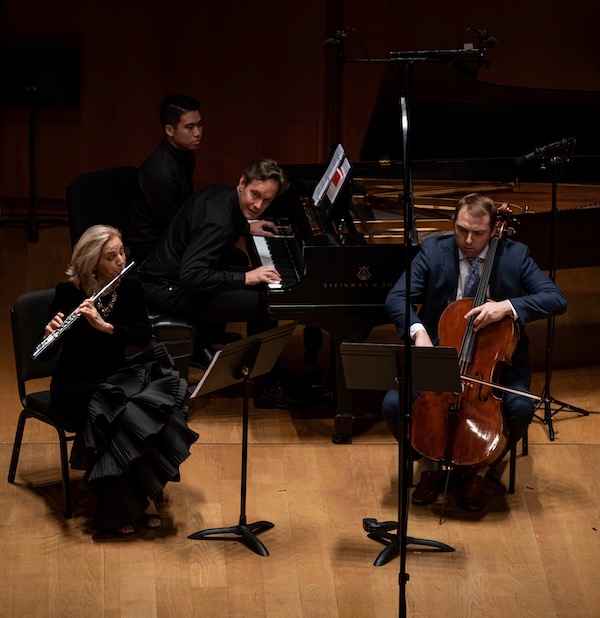Carol Wincenc fêtes a 50-year career with a pair of world premieres

The most memorable things about flutist Carol Wincenc’s 50th anniversary concert Tuesday night at the Morgan Library & Museum were how it began and how it ended.
At the appointed hour in the museum’s Gilder Lehrman Hall, the house lights went down, but the stage lights didn’t come up. Instead, the curling, hesitant phrases of Debussy’s Syrinx for solo flute wafted through the darkness. The sound had all the presence of a live performance, but without the usual visual distractions.
The thread of flute tone brightened and dimmed, paused and rushed ahead, flared and insinuated, and then went silent. The lights came up on the smiling honoree, flute in hand, who had just given the audience a vivid, if invisible, reminder of why they were all there.
Over the 50 years since she began her professional career—the “anniversary” refers to nothing more specific than the 1969-70 concert season–Wincenc has served as the muse for dozens of new compositions, a role celebrated Tuesday night with two world premieres.
The latter of these, Pierre Jalbert’s Air in Motion for flute and string quartet, closed the program with music so infectious and richly imagined that one could see it dancing straight into the permanent chamber music repertoire.
Between these impressive bookends, the program offered many opportunities to appreciate Wincenc’s career and artistic stature, beginning with an abridged version of Leonard Yakir’s bio-documentary film Carol Wincenc: The Ruby Concerts (played, unfortunately, at a booming, cineplex-style sound level that blew away the exquisite live Syrinx).
The film effectively mixed the artist’s on-camera reflections with photos of her growing-up years and notable mentors such as Jean-Pierre Rampal and Marcel Moyse. Images of her early concerts and travels included a strikingly Audrey Hepburn-like pose in front of a Roman fountain—a glamorous souvenir of the flute-boom years of the 1970s and ’80s, when Rampal and James Galway were hosting The Muppet Show, hot young flutists were ruling record-store racks, and high schools were creating whole flute bands to accommodate the demand.
Wincenc survived that frenzy to remain consistently in demand as a soloist, chamber music collaborator, teacher, and advocate for new works. She also handles a microphone better than composers Jalbert and Jake Heggie and cellist Brook Speltz, whom she engaged in a brief, intermittently-audible conversation onstage after the film.
Then it was time to let the music do the talking, with the world premiere of Heggie’s Full Circle Fifty for flute, cello and piano, an agreeable piece in four movements, with Speltz and Heggie at the latter two instruments. “Golden” was a romantic duet for flute and cello over a wandering piano figuration. “Travel Travails” was a jumpy evocation of an artist’s life on the road, with Heggie’s knocking on the piano case perhaps suggesting the maid wanting to clean the room.
There was nothing ornithological about “Hummingbird,” but rather a gentle evocation of Raymond Carver’s elegiac poem about death and love and remembrance. And “Full Circle” conjured the present from the past with Baroque-style counterpoint accelerating into a tarantella.
Although Wincenc’s digital brilliance and command of the long line were evident here and there, Heggie’s piece was not a particularly effective showcase for them. Its musical content, while pleasant, didn’t leave much of an impression either.
Mozart’s Quartet for Flute and Strings in C major, K. 285b, consists of just a pair of movements: a sonata-form Allegro with some startling modulations in the development, and a theme-and-variations arranged from the Wind Serenade, K. 361.
Wincenc and members of the Escher Quartet—violinist Adam Barnett-Hart, violist Pierre Lapoint, and cellist Speltz—played both movements without the indicated repeats, and the piece seemed to fly by. Just as well perhaps, as the performance sounded somewhat thrown together, without much sense of pace or direction.
This type of 18th-century piece normally features the player on top, but Wincenc, known as a generous collaborator, tended to blend into the ensemble sound. A touch of diva power—it was her night, after all—would have enlivened the performance.
Haste in preparing the Mozart piece would be understandable, given the rhythmic and timbral challenges posed by Jalbert’s new quintet, superbly performed by the above players plus (filling out the Escher Quartet) violinist Brendan Speltz.
The ensemble was on its toes for the quintet’s first movement, “Turning,” a whirlwind of shifting meters, string tremolos, and playful leaps on the flute. “Canon on 50 notes” made sound chemistry with strings playing staccato, pizzicato and spiccato by turns, combined with the flute playing their rising figure legato and in augmentation (half as fast).
“Air” surrounded a sultry low flute with airy harmonics and open fifths in the strings. Here Wincenc played with a keen awareness of when to emerge from the string texture and when to blend back in. There was something irresistibly French about this movement, as if Ravel had come back to compose in the 21st century.
The finale, “Pushing the Edge,” kept the listener guessing with scintillating staccato sections and languid flute adagios, handsomely displaying Wincenc’s sensitive use of vibrato and tonal range from cushiony to gem-hard.
If the ending was a little abrupt, the piece overall was clearly a find, an exciting and effective vehicle for flutists and quartets with the chops to master it, as Wincenc and the Eschers did most winningly Tuesday night.